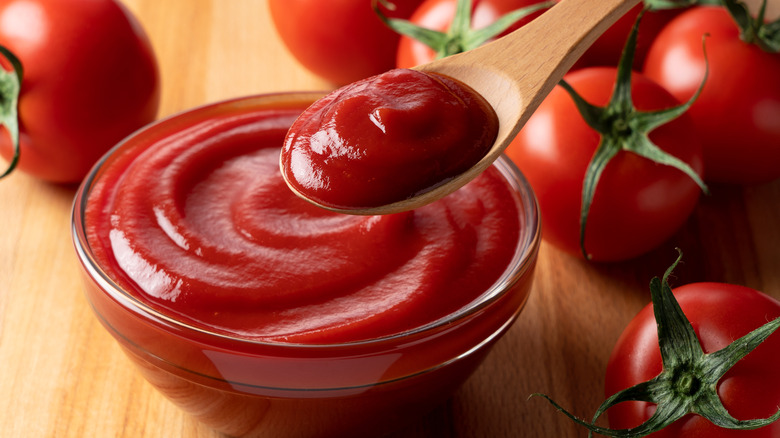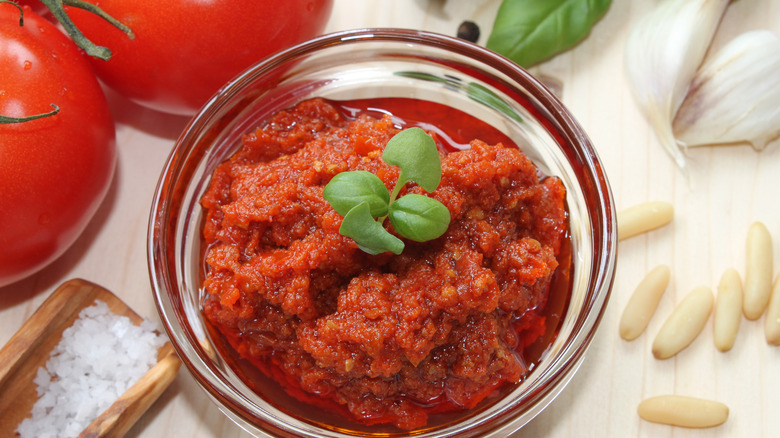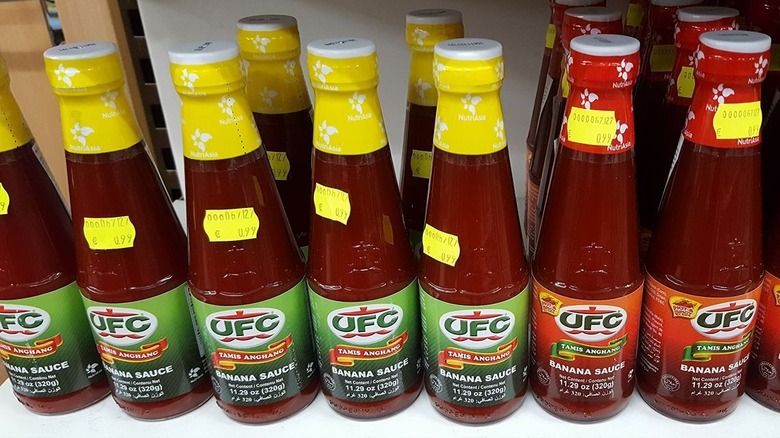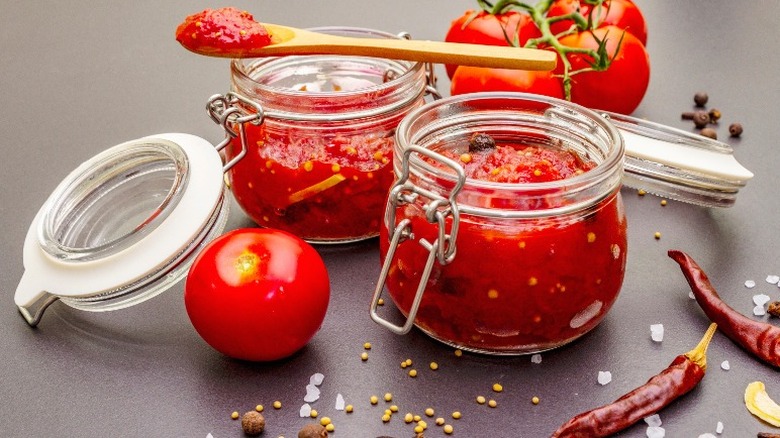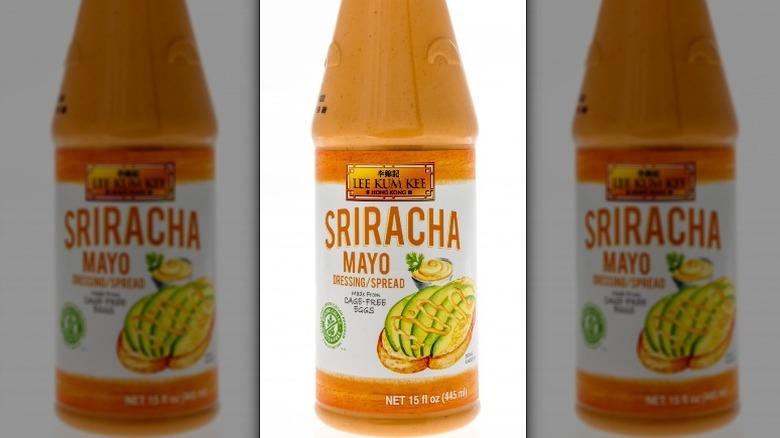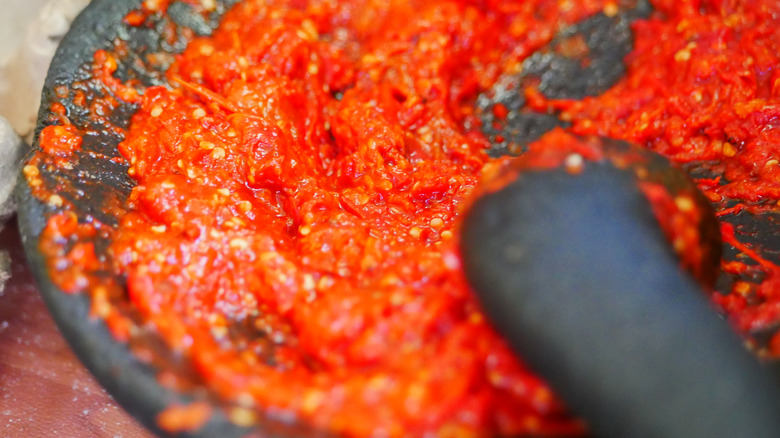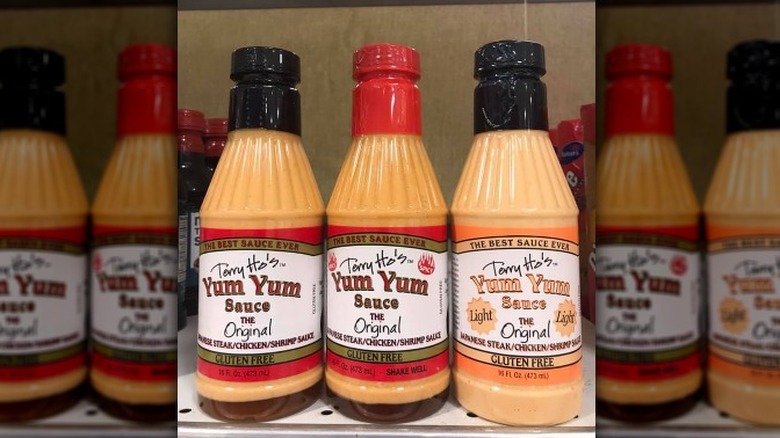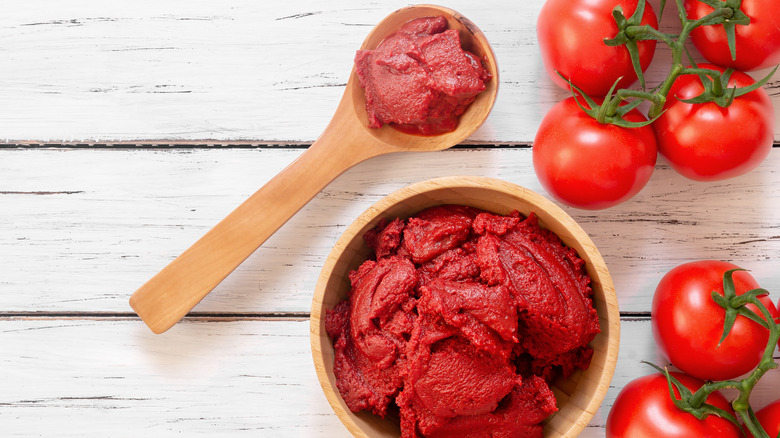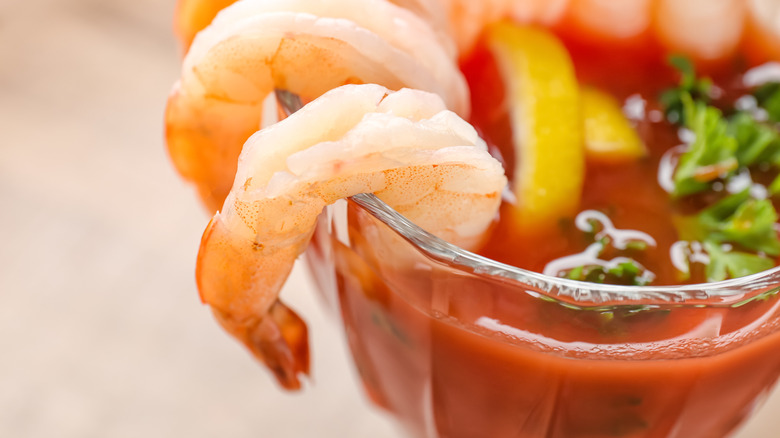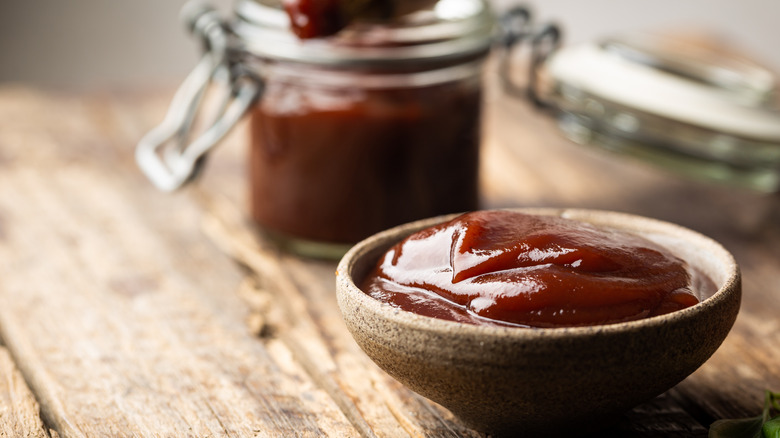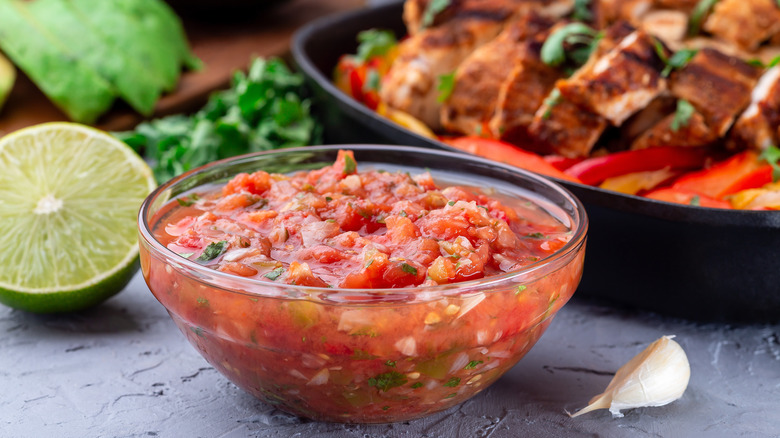Best Substitutes For Ketchup
Let's face it, there's nothing better than ketchup for topping a juicy burger. The sweet, tart condiment taps into memories of childhood cookouts and family barbecues. It's a tableside staple for use with fries, burgers, onion rings, and hot dogs. Additionally, the sauce can give an unexpected zing to Indian butter chicken, rich beef Bolognese, and stir fry dishes.
Last year, the global tomato ketchup market was an $18.5 billion industry — and growing (via Market Data Forecast). North America spends over $1.3 billion on the product, primarily fueled by its use as a sauce for various fast food staples like hamburgers, chicken fingers, and french fries. As fast food brands continue to expand internationally (particularly throughout Asia), we should expect to see further growth of this salty, sweet sauce.
Now, picture it: It's a Sunday afternoon with a backyard full of hungry friends enjoying the intoxicating aromas of burger patties wafting off your grill. You add the finishing touches to the condiment tray of lettuce and tomatoes, mustard, and mayo. You reach into the back of the fridge to grab the bottle of ketchup, only to find you've run out. With no time to go to the grocery store, you need a quick alternative for your meaty masterpieces and perfectly air-fried tater tots. What to do? Consider one of these flavorful options to keep you dipping and slathering.
Sun-dried tomato pesto
Ketchup has always been salty and tangy, but it didn't always contain tomatoes. As the story goes, the original ketchup was an umami-rich fish sauce from China (although some sources point to Indonesia) made with soy sauce. Ketchup's base went on to include walnuts, mushrooms, celery, and a plethora of other ingredients brought together with the addition of vinegar and warm spices, like mace and ginger.
Early on, the English enjoyed walnut ketchup, which lent an earthy bitterness to the condiment. Sun-dried tomato pesto often uses the heart-healthy, nutrient-dense tree nut as an alternative to traditional high-fructose corn syrup-filled ketchup. When reviewing the labels of pre-packaged sun-dried tomato pesto options, the standard serving size of two tablespoons includes a bit of fiber and protein, both lacking in typical ketchup, like Heinz. It also has less sodium and a quarter of the amount of sugar. It's perfect for topping chicken, bratwurst, zucchini noodles, or meatballs, but you can also use it as a dip for shrimp, fresh crudités, or veggie chips.
Banana ketchup
Want to try a new dip? Look no further than banana ketchup, an innovative product created by Maria Orosa, a Filipino food scientist, chemist, inventor, and WWII war heroine, notes Food 52.
Her goal was to bring sustainability to the Philippines, making the island country self-sufficient using native, regional ingredients like bananas (instead of heavily imported tomatoes). Tomatoes are a staple ingredient in many Filipino dishes, and they became hard to acquire during and after the war. However, bananas grow in abundance throughout the country. Orosa found that using the fruit as the sauce base resulted in a product with a surprisingly similar traditional tomato ketchup flavor. Plus, any Filipino could make it at home.
Today, banana ketchup is still commonly used throughout the Philippines and in areas with high Filipino populations. Various brands sit next to traditional ketchup on the shelves of local stores like KTA and Foodland in Hawaii.
To create a similar sauce, simply cook soft, ripe bananas mashed with garlic and onions, spices, honey or sugar, vinegar, and a bit of rum, then blend until smooth (via Serious Eats). Food coloring is added to commercial products as the color isn't as red as people are accustomed to, but the flavor will make you a convert. Use it interchangeably with regular ketchup while enjoying the variety of traditional dishes that use the condiment (like savory lumpia, fried bananas, and plantains).
Kasundi tomato chutney
Kasundi is a heavenly spiced condiment from India. Originating in Bengal, the chutney brings heavily toasted spices like ginger, allspice, cinnamon, and clove, together with key ingredients that are similar to ketchup including sugar, vinegar, and tomatoes. It traditionally uses malt vinegar and brown sugar, but any type of vinegar/sugar combo will work, particularly apple cider vinegar, which adds an additional hint of sweetness along with bright acidity. The sauce also brings a nice bit of heat from the use of Thai chili, which is traditional but can also be omitted if you prefer the flavor of spice instead of heat.
Similar to an Indian tomato achar, kasundi is used as a dipping sauce for samosas or chapati or for topping fried eggplant, fish, or potatoes. When substituting for ketchup, Travelle's Tim Graham adds the chutney to sandwiches, burgers, and fries, and uses it as a marinade for chicken, fish, or lamb.
Sriracha mayo
If ketchup is your ideal condiment for dipping french fries, consider substituting it for a spicy version of Belgium's favorite french fry dipping sauce, mayonnaise. The typical mayonnaise combo of eggs, oil, vinegar, and citrus juice becomes a spicy, creamy, tangy, mayo delight with the addition of sweet and spicy sriracha.
Though made in the U.S. by the Huy Fong company, the condiment is linked to the town of Si Racha, Thailand, where a similar version was first prepared bringing sweet, heat, and sour together in one flavor-packed sauce (via NPR). Today's Sriracha blends an abundance of chilis with vinegar, sugar, and salt. The combination of sriracha and mayonnaise makes the perfect drizzling sauce for spicy tuna hand rolls or California sushi rolls, fish tacos, and chicken sandwiches. Use it as a scrumptious, fiery sauce for chicken tenders, potato wedges, and onion rings. You can also mix it with a bit of sweet relish to make a salad dressing similar to Thousand Island with a kick.
Sambal oelek
Sambal oelek is another Huy Fong product that brings the warm heat of sriracha without the sugary taste. Sambal, which is similar to the Javanese word for sauce ("sambel"), is a chili pepper-filled Indonesian condiment that's predominantly made up of chili peppers with various other ingredients like garlic, onions, shrimp paste, or fish sauce, according to 196 flavors. Oelek comes from the Dutch word "ulek" for pestle. Mashing fresh chilis with a mortar and pestle into a thick, textured paste delivers a vibrant, authentic, bright chili flavor.
Sambal oelek is perfect as a spicy marinade for skirt steak, swordfish, or pork ribs. One tablespoon is equal to the amount of heat in one small jalapeño, and 1 teaspoon is equivalent to about a quarter teaspoon of red pepper flakes. Use this fresh chili flavor as a topping for sausage or vegetable frittata instead of ketchup or other tomato products.
Yum Yum Sauce
If you love the tang in ketchup and the creaminess of an aioli, Yum Yum is the perfect dipping sauce for your fries. It's a staple sauce of Japanese steakhouses, blending mayonnaise with tomato paste, rice or apple cider vinegar, a savory blend of spices, and butter. The butter and mayo come together to create an excessively indulgent, dreamy sauce.
Yum Yum sauce is perfect for topping beef, lamb, or turkey burgers, dipping sweet potato fries, or adding tang to rotisserie chicken or roasted turkey sandwiches. To ensure your reaction to the sauce's flavor delivers the double "yum" factor, use the highest quality ingredients when making it at home. Like the Japanese Kewpie mayo, which uses four egg yolks for every 500g of sauce, giving it a texture reminiscent of a custard while elevating the total flavor experience.
And if you run out of time to make this DIY sauce, pick up a bottle of one of the many pre-packaged options lining store shelves at local markets today, like Terry Ho's Yum Yum Sauce.
Tomato paste
At its base, tomato paste is most similar to ketchup for cooking. Thick and rich, tomato paste is slowly cooked down for hours to remove the abundant water tomatoes contain, concentrating and intensifying the flavors. With this, the inherent acidity of tomatoes mellows, leaving a well-rounded, slow-cooked flavor. There is also a natural, caramelized sweetness from the fruit without adding sugar. Add a touch of salt and a splash of vinegar to mimic ketchup's authentic flavor and thinner texture. Use the blend as a one-to-one swap for ketchup as a spread on meatloaf before baking. Or, fold it into meatballs, turkey burgers, Bolognese, and chili for richness and depth of flavor.
Though tomato paste is an excellent alternative to ketchup, swapping the other way around is not a good idea due to the additional sugar, vinegar, and spices found in ketchup.
If you find you only have a can of tomato sauce or tomato puree instead of tomato paste, that can also work. Pour the contents of the can into a pan over medium-high heat to reduce the amount of water, but don't walk away from the pot — keep an eye on it. Stir often to ensure it doesn't burn. Then, throw in a splash of balsamic vinegar to give your sauce the sweetness and tart bite of ketchup.
Cocktail sauce
No crawfish, shrimp, or crab boil would be complete without a serving of cool cocktail sauce on the side. Traditionally, chili sauce is used as the base for cocktail sauce (and we don't mean the sweet one from Thailand, but rather the tomato paste-based chili sauce). The chili sauce brings slow-cooked, tomato-filled richness to the mix with a hint of acidity thanks to vinegar and flavor-filled seasonings like garlic, onion, and pepper. To complete the cocktail sauce, mix in spicy horseradish, lemon juice, and what we — and Chef Alex Guarnaschelli — think is the umami-rich seasoning of the gods: Worcestershire sauce. Made by mixing 18-month-aged anchovies, barley malt vinegar, molasses, and seasoning, the fermented Worcestershire sauce gives a salty savoriness to anything it touches, from Bloody Mary cocktails and Caesar salad to various condiments — including cocktail sauce.
Cocktail sauce has almost the same texture, consistency, and color as ketchup, making it an easy swap as a zippy dipping sauce perfect for frito misto, potato wedges, veggie tots, and crab ravioli. Add a bit of honey and soy sauce to the cocktail sauce, creating a dip for crispy pot stickers or a glaze for chicken or pork chops.
Barbecue sauce
Barbecue sauce has a lot in common with ketchup — both use tomato, vinegar, and sugar as their base. But barbecue sauce takes it up a flavor-packed notch. Often, the brisket-topper includes a variety of spices, a kick of fiery heat from peppers, that umami-heavy "secret" Worcestershire sauce, and liquid smoke. Barbecue sauce also typically gets its sweetness from slow-cooked molasses or brown sugar instead of cane sugar, which also imparts a dark, rich flavor.
Not all barbecue sauce is alike. Kansas City-style barbecue sauce best mimics ketchup's consistency and tomato-rich sweetness thanks to its blend of tomatoes and molasses. St. Louis-style sauce adds cider vinegar, and though thinner than ketchup's consistency, the flavor is comparable.
Barbecue sauce makes the perfect alternative when cooking. It will give a smoky richness to sloppy joes, meatballs, or pulled pork egg rolls. Use the option as a marinade and glaze for chicken kabobs or lip-smacking baked chicken wings.
Steak sauce
Steak sauce taps into the comforting homeyness of ketchup and amplifies it with a pungent kick of acidity. With a base of ingredients that are incredibly similar to ketchup, steak sauce can act as a quick and flavorful swap for the condiment. The grandfather of all steak sauces, A.1. Sauce, dates back to 1862, and it originally contained dried fruits, Eastern spices, and vinegar (via Smoked 'N Grilled.) Not only did the sauce help mask the flavor of decaying meat in the royal kitchens of Britain's King George IV, but the vinegar-heavy sauce also acted as a meat tenderizer.
Today, A.1. (along with similar brands) mixes tomato paste, vinegar, sugar, and spices (A.1. still includes raisin puree) for a zippy accompaniment or marinade. Use steak sauce as a tenderizing marinade for ribs, beef fajitas, chicken thighs, or buffalo steaks, or serve it alongside burgers and baked potato wedges for a zesty lift to the starchy creaminess of the potato.
Apple cider vinegar
Apple cider vinegar is the ideal meat-tenderizing and flavor-enhancing marinade to use instead of ketchup. Though the texture and consistency are nothing alike, vinegar is the key ingredient that gives ketchup its zing and mouth-watering liveliness. Cider vinegar brings a bit of that similar sweetness with that zingy acidity to any dish. It is the perfect option for chewier cuts of meat you want to tenderize quickly as the vinegar will break down the proteins in the flesh, reducing the tough texture and making it softer, shares Oliver and Grapely.
Try cider vinegar as a tenderizer for venison, lamb shoulder, and buffalo steaks, as well as chicken thighs, pork shoulder, and oily white fish like cod. The critical element to understand is timing. More delicate proteins will tenderize faster than the more fibrous ones. You may want your chicken thighs to be softer but not mushy. Add a splash to olive oil, honey, and soy sauce to create a bright, lively marinade for grilled vegetables or chicken breasts.
Salsa
Salsa is much more than just a condiment. At its core, it may not be the obvious substitute for ketchup, as salsa tends to be more savory than sweet. But there's nothing better to top shrimp, beef, or chicken tacos with. It adds a fresh and spicy liveliness to scrambled eggs and vegetable frittatas, too. It also lends a warm piquant essence to meatloaf, hamburger steaks, or grilled tri-tip.
Made by mixing tomatoes with jalapeño peppers or chipotles, garlic, onions, fresh herbs like cilantro and oregano, fresh lemon or lime, and salt and pepper, there's no added sugar, making it a good option if you are watching your sugar intake. When making homemade salsa or using salsa from a jar, pop it into a blender and give it a whirl or two to create a similar consistency to ketchup. Since there is a nice bit of acid in the sauce, salsa is a great marinade and sauce for fish, pork, and chicken — especially slow-cooked versions.
